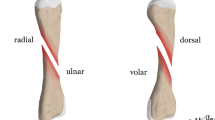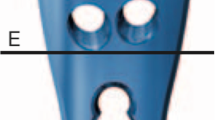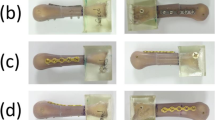Abstract
Purpose
The aim of this study was to determine the biomechanical characteristics of locking plates with the TriLock system with different design and screw settings compared to a non-locking plate in a diaphyseal metacarpal fracture.
Methods
Oblique diaphyseal shaft fractures in porcine metacarpal bones were created in a biomechanical fracture model. After reduction they were fixed with three different locking plates with the TriLock interlocking mechanism or a non-locking linear plate in mono- or bicortical screw fixations. In load to failure tests the maximum load and stiffness were measured.
Results
For linear plates, the maximum load was higher for the non-locking plate compared with the locking plate. The maximum load could be increased for the locking plates using a double-row design and a higher screw number. No differences were found for the stiffness between all groups. In contrast to the non-locking plate, the mode of failure of the locking plates in many cases (86 %) was a loss of the interlocking mechanism.
Conclusions
The results suggest that the locking plates with the TriLock system achieve no higher stability compared to a non-locking plate in load to failure tests. Adaptions to increase the stability of the interlocking mechanism are desirable.





Similar content being viewed by others
References
Feehan LM, Bassett K (2004) Is there evidence for early mobilization following an extraarticular hand fracture? J Hand Ther 17(2):300–308
Black D, Mann RJ, Constine R, Daniels AU (1985) Comparison of internal fixation techniques in metacarpal fractures. J Hand Surg Am 10(4):466–472
Firoozbakhsh KK, Moneim MS, Howey T, Castaneda E, Pirela-Cruz MA (1993) Comparative fatigue strengths and stabilities of metacarpal internal fixation techniques. J Hand Surg Am 18(6):1059–1068
Mann RJ, Black D, Constine R, Daniels AU (1985) A quantitative comparison of metacarpal fracture stability with five different methods of internal fixation. J Hand Surg Am 10(6 Pt 2):1024–1028
Prevel CD, Eppley BL, Jackson JR, Moore K, McCarty M, Sood R, Wood R (1995) Mini and micro plating of phalangeal and metacarpal fractures: a biomechanical study. J Hand Surg Am 20(1):44–49
Prevel CD, Katona T, Eppley BL, Moore K, McCarty M, Ge J (1996) A biomechanical analysis of the stability of titanium bone fixation systems in proximal phalangeal fractures. Ann Plast Surg 37(5):473–481
Gajendran VK, Szabo RM, Myo GK, Curtiss SB (2009) Biomechanical comparison of double-row locking plates versus single- and double-row non-locking plates in a comminuted metacarpal fracture model. J Hand Surg Am 34(10):1851–1858
Ochman S, Doht S, Paletta J, Langer M, Raschke MJ, Meffert RH (2010) Comparison between locking and non-locking plates for fixation of metacarpal fractures in an animal model. J Hand Surg Am 35(4):597–603
Massengill JB, Alexander H, Parson JR, Schecter MJ (1979) Mechanical analysis of Kirschner wire fixation in a phalangeal model. J Hand Surg Am 4(4):351–356
van Onselen EBH, Karim RB, Hage JJ, Ritt MJPF (2003) Prevalence and distribution of hand fractures. J Hand Surg Br 28(5):491–495
Brand PW, Hollister AM (1999) Clinical mechanics of the hand, 3rd edn. CV Mosby, St. Louis
Ochman S, Vordemvenne T, Paletta J, Raschke M, Meffert R, Doht S (2011) Experimental fracture model versus osteotomy model in metacarpal bone plate fixation. Sci World J 11:1692–1698
Acknowledgement
The authors would like to thank Christopher Gebhardt for supporting the experimental study and result calculation. Furthermore, they would like to thank Gabi Walter from Heraeus Medical GmbH for supplying the bone cement, Palacos. The authors thank Torsten Blunk for critically reviewing the manuscript.
Conflict of interest
The authors declare that they have no conflict of interest.
Author information
Authors and Affiliations
Corresponding author
Rights and permissions
About this article
Cite this article
Doht, S., Jansen, H., Meffert, R. et al. Higher stability with locking plates in hand surgery? Biomechanical investigation of the TriLock system in a fracture model. International Orthopaedics (SICOT) 36, 1641–1646 (2012). https://doi.org/10.1007/s00264-012-1524-7
Received:
Accepted:
Published:
Issue Date:
DOI: https://doi.org/10.1007/s00264-012-1524-7




